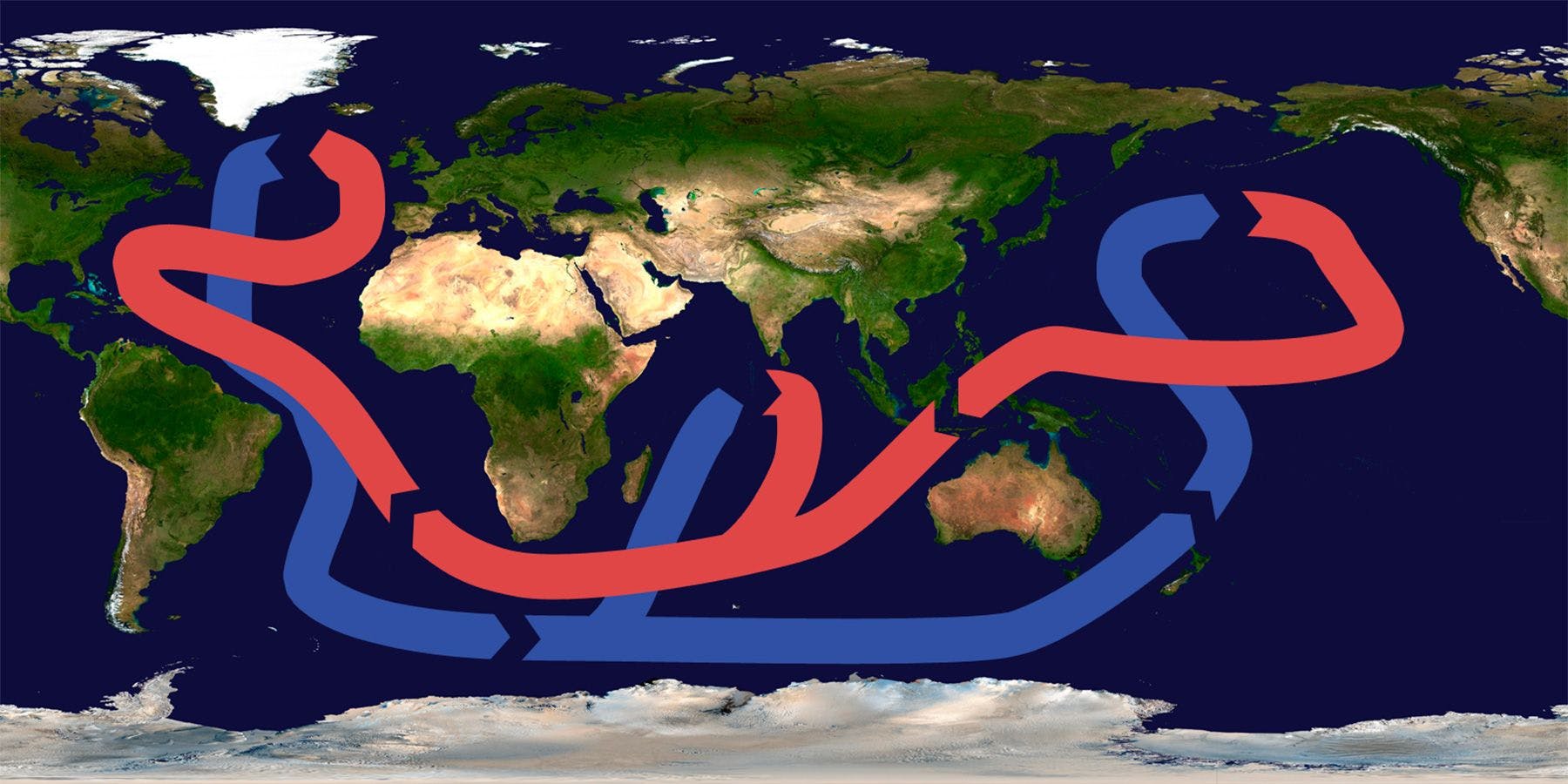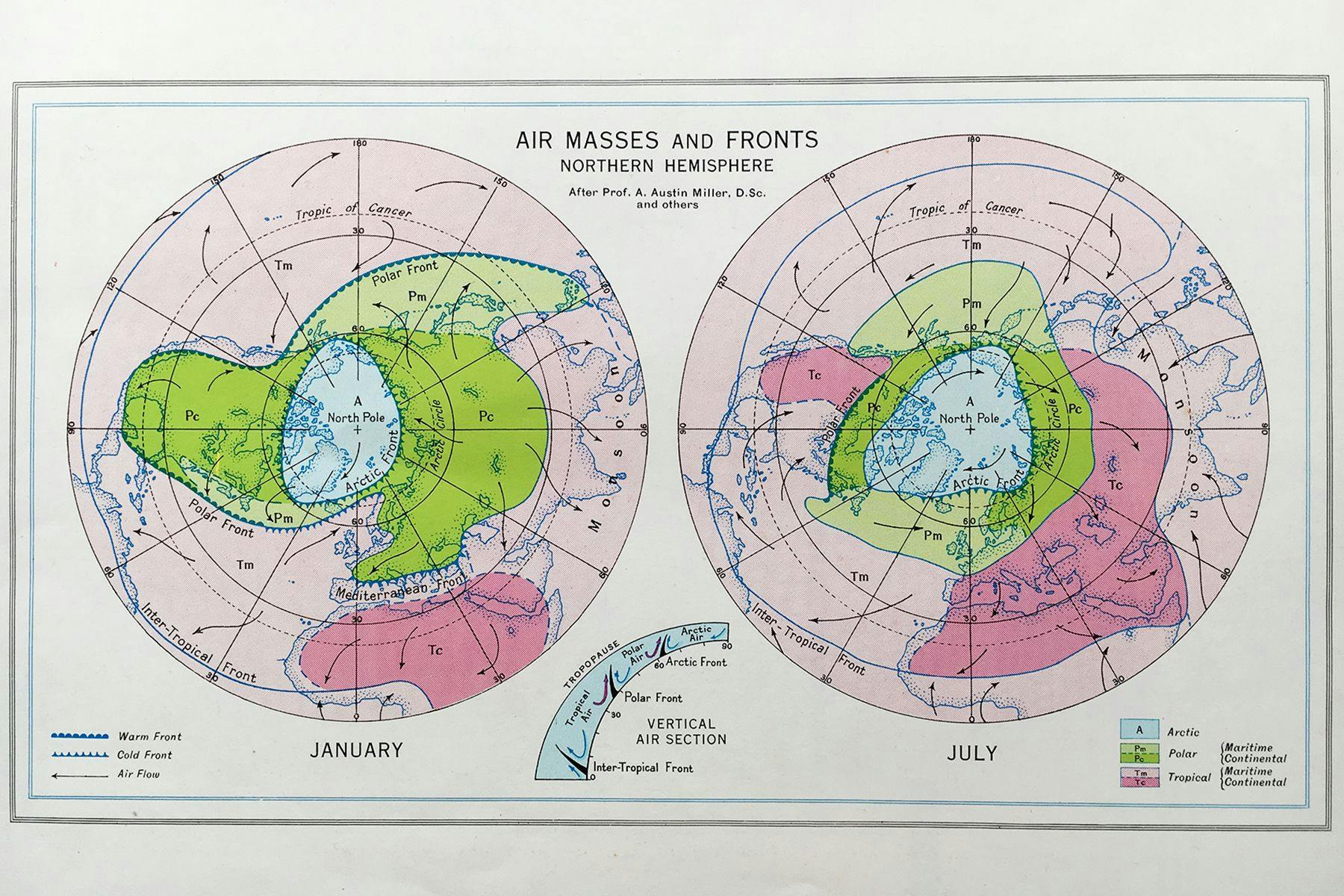Science & SkepticismGulf Stream: The Atlantic Conveyor and Climate

Climate change, caused by human activity, is an indisputable scientific fact and 2019 could well prove to have been the year when the balance tipped and society woke up to the crisis that is has created. The oceans play a major role in regulating Earth’s climate and the myriad impacts of global warming on them are both alarming and also not entirely predictable, because of the inter-relationships of a large number of variables. One scenario that is frequently rolled out by European media is that rising sea temperatures and a reduction in salinity in the far North Atlantic due to the introduction of melting freshwater (from glaciers and thawing permafrost) could result in a significant slowing or halting of the Gulf Stream and the “Atlantic conveyor”, leading to Europe being plunged into a “new mini-Ice Age”. Whilst the Gulf Stream does indeed contribute to Western Europe’s relatively warm climate, there is a growing agreement amongst leading climate scientists on both sides of the Atlantic that it is actually far less influential than the popular consensus perpetuated by mainstream media. Whilst surfers in the northeast of the United States brave blizzards and brutal cold through the winter months, their counterparts at the same latitudes on the other side of the Atlantic can enjoy average air temperatures that are 15-20 degrees Celsius (59-68 degrees Fahrenheit) higher. Should European surfers start investing in thicker neoprene? The science suggests that, as far as the impact of changes to the Gulf Stream goes, the outlook might not be as bleak as we’ve all been lead to believe.
The Oceans’ Role In Regulating Climate
When it comes to the Earth’s complicated climate, everything is interrelated. The oceans though, covering 71% of the planet’s surface, play a huge role. Oceans and the plants that grow in them absorb carbon dioxide from the atmosphere (mangroves, seagrass beds and salt marshes have been reported to store at least ten times more carbon than continental forests), and they absorb, store and transport heat from the sun as well as the heating from human-caused greenhouse gasses in the atmosphere. They are the drivers of the planet’s weather systems, birthing the powerful storms that create the waves that we surfers enjoy so much.
The Gulf Stream: Europe’s Warm Water Delivery System
The Gulf Stream is an oceanic current that originates in the warm waters of the Gulf of Mexico and carries warm water through the Florida Straits and north up the eastern seaboard of the United States and Newfoundland before crossing the Atlantic to Northern Europe where the current becomes the North Atlantic Drift. It is a wind-driven western-intensified current that loses heat to the overlying atmosphere as it travels, and the evaporation that occurs increases the salinity of the seawater to the point at which, in the North Atlantic Ocean, it becomes cold and dense enough to sink. At this point the current is a thermohaline circulation (a current driven by differences in the temperature and salinity/density of the water mass), with the water that sinks in the North Atlantic flowing back towards the tropics along the east coast of North America in the deep ocean. This entire system of water-borne heat exchange is known as the “Atlantic conveyor”, and forms part of the North Atlantic gyre.

Thermohaline circulation around the world’s oceans. Reproduced under a Creative Commons Attribution-Share Alike 3.0 Unported license.
The Gulf Stream is responsible for transporting considerable amounts of heat to the northern Atlantic Ocean, hence it being frequently (but likely incorrectly) cited as the reason for Northern Europe’s climate being relatively mild in comparison to the same latitude on the East Coast of North America.
Climate Modelling and Ocean Currents
The assertion that without the Gulf Stream Northern Europe would be plunged into a “mini Ice-Age” in the popular media and amongst many members of the general public is often based on assumption and the proliferation of outdated or intentionally vague science, some of which dates back to the 19th Century. With two recent studies from 2018 finding that the Gulf Stream was the weakest that it’s been in at least 1,600 years, the role and presumed importance of the Gulf Stream within the climate change narrative is recurring with increased frequency,
In recent years it has been the subject of increased scrutiny from climate scientists using incredibly powerful climate modelling programmes, many of who have challenged the accepted wisdom and suggested that its influence upon regional climate is not as great as previously thought.
“What we did in this study was to use climate models in a different way. Rather than include absolutely everything in the climate system that could be important we removed certain parts, in particular the ocean circulation, and asked “how much can we explain without that?” It turns out, that you can explain a lot without that.”
– Professor Amy Clement, Department of Atmospheric Sciences at the University of Miami
Professor Amy Clement of the Department of Atmospheric Sciences at the University of Miami is one of these climate scientists. Clement and her colleagues are the latest scientists to use the powerful and very specialised computers that forecast weather to run scenarios in which the effects of the changing ocean circulation were removed.
What they found was very much in line with the research of various notable climate scientists before them (including those from the National Oceanic and Atmospheric Administration’s (NOAA) Geophysical Fluid Dynamics Laboratory at Princeton University) dating back to the late 1970s: removing the North Atlantic thermohaline circulation from models resulted in a projected cooling of a few degrees on land masses on both sides of the North Atlantic, but didn’t have a significant impact upon the large temperature differential that would persist between the East Coast of North America and Europe.
What Causes Europe’s Mild Climate?
If oceanic heat transport is not the cause of Western Europe’s mild climate in comparison to the East Coast of North America, then what is? As mentioned in the introduction, climate is the result of the interaction of a large number of variables and there are several processes that can be looked to as the causes of this difference in temperature.
The Ocean as a Heat Sink
Both the oceans and landmasses absorb and release heat from the sun, but the oceans are a far larger and more dynamic heat sink. Heat is mixed downwards in the oceans (due to wind action) to depths of tens of metres, whereas heat absorbed by rock and soil is not dissipated in the same way and remains close to the surface. An ocean is therefore a larger heat sink than a land mass volumetrically, and also because water has such a high heat capacity. Add to this that a solid mass will heat up and cool down faster than a liquid and the result is that the temperature profile of the oceans (and adjoining landmasses with a maritime climate) is less extreme than a continental land mass.
Atmospheric Air Flows (Wind)
In the mid and higher latitudes where air flows from west to east, there is a distinct and large-scale waviness in lower atmosphere wind patterns. This is caused by air passing over mountain ranges being compressed between the elevated land and the tropopause (the stable atmospheric boundary between the troposphere and the stratosphere that acts like a lid, and that sits at a lower altitude in higher latitudes) where the law of the conservation of angular momentum causes the air mass to move south, and conversely at sea level where it moves north. Over continental North America, the deflecting influence of the Rocky Mountains carries cold air from the Arctic down across the central and eastern United States, with the “rebound” sending warmed air from the subtropics northeastwards across the Atlantic towards Europe.

Professor Richard Seagar of the Lamont-Doherty Earth Observatory at Columbia University and Professor David S. Battisti of the University of Washington removed the Rocky Mountains from their climate models in a 2002 study, and found that the temperature difference between both sides of the Atlantic was halved, leading them to conclude that the difference is caused “about equally” by waviness in atmospheric air flows as it is by the contrasting continental (USA) and maritime (Western Europe) climates.
What Might Happen If The Atlantic Conveyer Slows?
If concentrations of atmospheric greenhouse gasses are not stabilised or reduced urgently, then the majority of atmosphere-ocean models predict that climate change will cause the Atlantic conveyor to slow. This will be caused by the warming and “freshening’ of the far North Atlantic Ocean (in the sub-polar region) from increased precipitation, freshwater run-off and melting of polar ice which will dilute and reduce the salinity of the water on the oceans surface. Less saline water is less dense therefore will not sink so readily, putting the brakes on the North Atlantic’s thermohaline circulation.
Should that scenario play out and the Gulf Stream slows or stops, specialists predict that the impact on the region’s climate, and that of Western Europe in particular, would be a drop of a few degrees in average temperatures across the whole system. They would expect the significant difference in temperatures to remain. Moreover, the cooling that a slowing Gulf Stream would trigger would very likely be balanced out by the corresponding warming of the atmosphere in general due to climate change and its myriad inter-connected impacts. In short, these notable climate scientists predict that temperatures would fall as a result, but not to the levels that make for a good ol’ media myth. For North Atlantic surfers, it might mean that you’ll be comfortable with an extra millimetre of neoprene on your wetsuit and that you’ll want to wear your hood and booties for a few more weeks. But by then your favourite surf spot could have been consumed by rising sea levels and you’ll have plenty of bigger worries to concern yourself with.
Surf Simply and the author would like to thank Professor Amy Clement of the Department of Atmospheric Sciences at the University of Miami for her input and assistance.